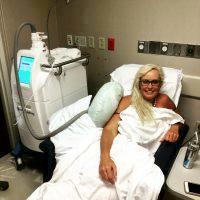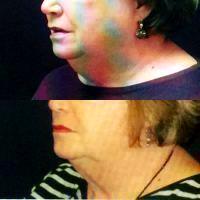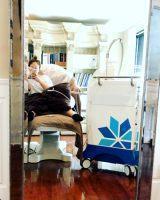Does Coolsculpting Get Rid Of Loose Skin?
Coolsculpting and Loose Skin
If you have already experienced a loss of elasticity to your skin, you must be cautious as to the treatment performed. Because Coolsculpting is designed to remove fat, the skin will be left more empty and there is a possibility it could become looser.
This does, however, depend on the area treated and the connectivity/elasticity of the skin in this area. (Michael E. Ciaravino, MD, Houston Plastic Surgeon)
CoolSculpting and Skin Laxity
CoolSculpting is designed to reduce fat. It does not usually create extra skin laxity, nor does it improve preexisting skin laxity.
It is always best to get a consultation to determine if you are a good candidate for the treatment and assess your skin laxity in the area of concern. (Steven H. Williams, MD, San Francisco Plastic Surgeon)

CoolSculpting Uses A Special Device That Targets The Fat Cells With Freezing Temperature
Skin laxity
While coolsculpting has achieved FDA approval for fat reduction, it can provide skin tightening benefits. Patient selection is key.
It is important to go to a provider who can provide multiple options ( both surgical and coolsculpting) so the best option can be used for you. (Kris M. Reddy, MD, FACS, West Palm Beach Plastic Surgeon)
Other procedures may help skin laxity but not Coolsculpting
Coolsculpting does not address the issue of skin laxity like some other noninvasive fat destruction modalities. If skin laxity is the primary issue then other methods may provide a better result. (Joshua L. Fox, MD, Long Island Dermatologic Surgeon)
Will Cool Sculpting (Zeltiq) Address Skin Laxity?
Coolsculpting only removes fat and the company does not promote skin shrinkage. If you have a large amount of skin surgery would be a better choice. However, most cool sculpting practices have seen skin shrinkage in patients as have I. (Kurtis Martin, MD, Cincinnati Plastic Surgeon)

Coolsculpting Under Chin Before And After
CoolSculpting Does Not Remove Skin Laxity
Coolsculpting represents a significant advance in the treatment of problem fat collections. The technique has been clinically proven and has FDA approval. Despite its success, the procedure does have limitations. Coolsculpting is effective for fat deposit removal, but has little effect on skin laxity.
When patients have good skin elasticity and small amounts of fat are removed the skin often tightens on its own. When patients have poor skin elasticity and large amounts of fat are removed the skin very rarely snaps back.
In these situations, removal of the underlying fat often makes the sag much worse. If skin laxity is a primary concern then other options should be considered. Consultation with a board certified plastic surgeon is an appropriate next step. (Richard J. Bruneteau, MD, Omaha Plastic Surgeon)
CoolSculpting & Skin Laxity
CoolSculpting is designed to reduce the volume of fat in isolated areas. Sometimes the skin will tighten and sometimes it will not. You should not undergo CoolSculpting planning on a definite improvement in skin laxity. (John J. Edney, MD, Omaha Plastic Surgeon)
CoolSculpting and Skin Laxity
CoolSculpting is not a good option for loose skin. But, for people with excess fat and skin that is not taught, we suggest laser skin tightening as an adjunct treatment. We are particularly enthusiastic about results for improving upper arm areas by reducing size with CoolSculpting and enhancing skin tone with laser skin tightening. (Michael Law, MD, Raleigh-Durham Plastic Surgeon)
CoolSculpting works on fat
CoolSculpting works below the skin and effects the fat by creating signals inside the fat cells that cause their gradual destruction. CoolSculpting has no effect on the overlying skin, and will not increase or decrease the elasticity of your skin.

The Layers Of Fat Cells Are Destroyed
You should expect a reduction in the size of the fat bulge but no difference in the lax skin with CoolSculpting.
If skin is the problem, you should ask your plastic surgeon about specific means to address this- you may have several great options here as well. (Adam David Lowenstein, MD, FACS, Santa Barbara Plastic Surgeon)
Coolsculpting and loose skin
Coolsculpting is great for treating exercise-resistant fat, but not excess skin. Therefore, you may need to have the skin removed after the Coolsculpting treatments. (Jeffrey E. Schreiber, MD, FACS, Baltimore Plastic Surgeon)
Cannot address skin laxity
CoolSculpting cannot address skin laxity because it works by freezing fat cells and does not cause contraction of fibrous septi or collagen of skin. However, it is possible through treatment with LipoSonix which uses Ultrasound therapy to raise the temperature above 55-60 C at which point collagen molecules undergo structural transformation which translates into skin tightening.
This seems theoretically plausible, but has not been confirmed through trials. (Cameron Rokhsar, MD, FAAD, New York Dermatologic Surgeon)
CoolSculpting and skin laxity
What would happen to the skin laxity after CoolSculpting. We see only good retraction and if the skin is very lax it is not worsened. The other question is what happens with treatment of the banana roll.
Similar to areas that are treated conservatively or avoided in liposuction, I would be cautious in areas that are known to drop after liposuction when doing CoolSculpting, especially in an off-label area. Further studies may need to be done, or information disseminated of those that have been done.
As CoolSculpting only reduces the fat by about 20% in volume after one treatment and it occurs slowly over four months after the procedure, and as there is no traumatic tunnels excavated as is in liposuction which can interfere with the structural support of the overlying tissue, I would expect good retraction after CoolSculpting. (Ronald Shelton, MD, Manhattan Dermatologic Surgeon)

There Are No Lasting Scars From Incisions
Skin Laxity does not seem to worsen after Coolsculpting by Zeltiq
As long as you do not have stretch marks in the area, the skin does seem to respond nicely to the reduction in fat.
We have not had anyone experience a worsening or development of the appearance of excess skin, regardless of area treated. (Armando Soto, MD, FACS, Orlando Plastic Surgeon)
Cool Sculpting by Zeltiq and Skin Laxity
Cool Sculpting by Zeltiq is a treatment to reduce fat and only fat. The scientific method used in cool sculpting by Zeltiq is called “cryolipolysis” which basically means the freezing of fat causing programmed cell death.
The skin does not get affected by the cold which means to also say that it does not cause skin tightening or smoothing. There are lasers that do improve skin laxity such as the Velashape and Sciton’s Skin tyte as well as Thermage.
When you come in for a consultation, the medical provider will access your skin and fat and let you know which modalities would work best for your condition. (Amir Moradi, MD, San Diego Facial Plastic Surgeon)
Zeltiq Coolsculpting is not for lax skin
Coolsculpting using Zeltiq machine will not improve or tighten lax skin. It will , however, remove localized fat bulges in active adults. It works great for love handles and abdomen and is safe and noninvasive. (Steven Hacker, MD, West Palm Beach Dermatologic Surgeon)
Cool sculpting and skin laxity
Cool sculpting is a treatment for fat reduction. It does not address skin laxity.
You can undergo other treatments for skin laxity such as vela shape or thermage. (Lori A. Brightman, MD, New York Dermatologic Surgeon)
CoolSculpting and Skin Laxity
CoolSculpting is not a procedure to improve skin laxity. CoolSculpting will effectively remove the fat layer, with maximum reduction seen approximately two to three months after the treatment was done. Because of this gradual fat layer reduction, the skin overlying the fat has time to accommodate and ‘bounces’ back nicely.
In fact, we have even witnessed patients treated who have somewhat pendulous abdomens, where the skin and tummy lift up, and the pendulous or sagging abdomen is remarkably improved. This is not to be confused with excessive skin laxity, where the skin has lost elasticity, is ‘redundant’ or excessive, and cannot ‘bounce back’ even with a simple pinch or pull test. (Leyda Elizabeth Bowes, MD, Miami Dermatologic Surgeon)